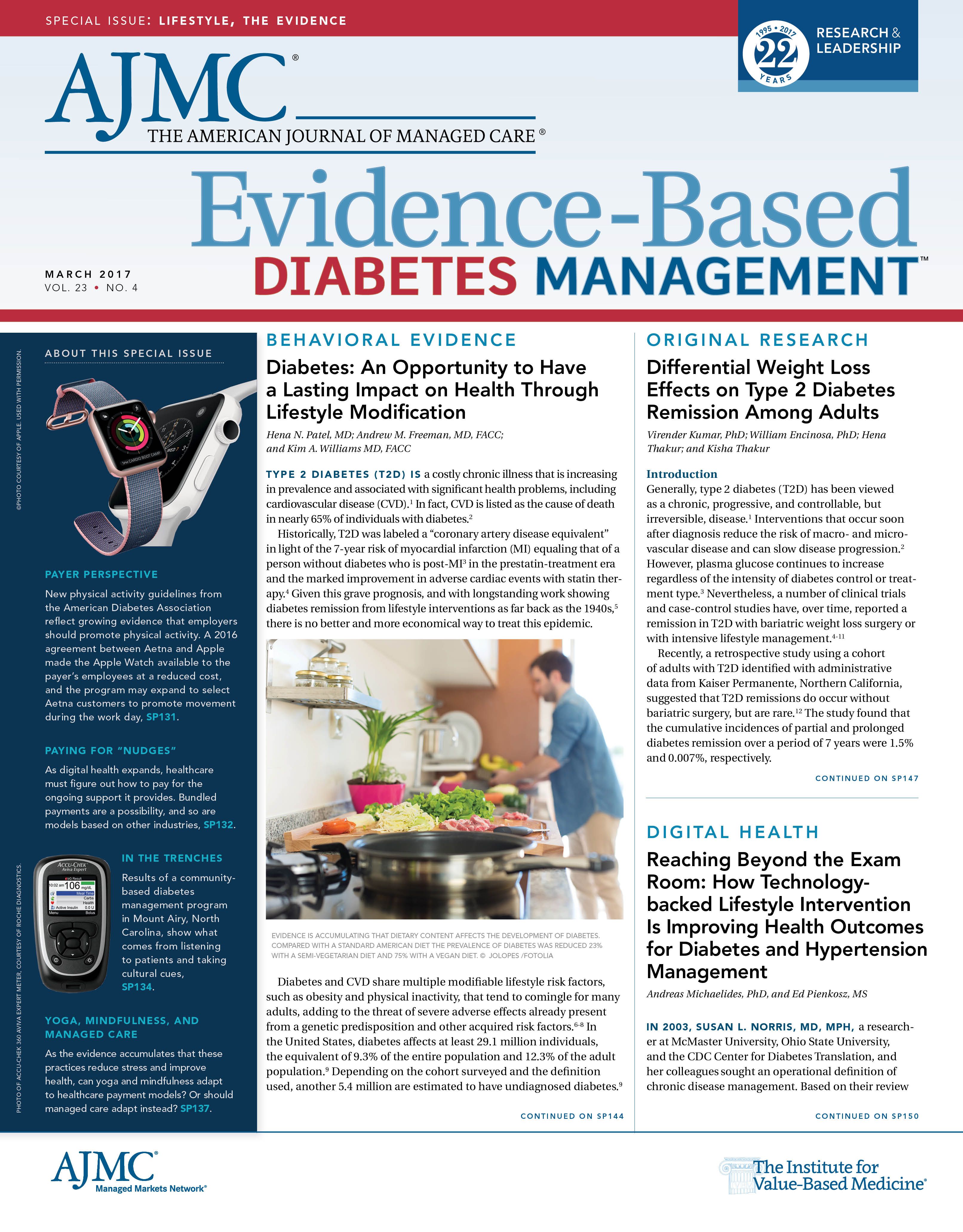- Center on Health Equity & Access
- Clinical
- Health Care Cost
- Health Care Delivery
- Insurance
- Policy
- Technology
- Value-Based Care
From the Editor in Chief: Why WAIT Results Highlight the Value of Lifestyle Intervention
Five-year results of the Why WAIT study at Joslin Diabetes Center.
More change is coming to the US healthcare system. Experts agree, however, that some things the Affordable Care Act set in motion should not change, including the focus on preventing chronic disease. In diabetes care, we are familiar with this statistic: the disease costs the United States $245 billion a year in medical costs and lost productivity.1 Therefore, since it’s been shown that it costs 2.3 times more to care for someone with diabetes than a person who stays free of disease, preventing diabetes, or stopping its progression, has the potential to save Medicare billions of dollars.2
While genetics certainly plays a role in who develops diabetes, improvements in lifestyle—through healthier diets, more (or different) exercise, getting enough sleep, and reducing stress—can go a long way toward preventing diabetes or slowing complications among those already diagnosed. For years, the secrets of helping people stick with healthier habits have proved elusive—but
this is changing.
At Joslin Diabetes Center, we’ve spent years following the success of the Why WAIT study, led by Osama Hamdy, MD, PhD, FACE. Why WAIT (Weight Achievement and Intensive Management) is an initial 12-week multidisciplinary intervention for obese patients who have diabetes. It combines disease management, improved nutrition, and exercise, especially the maintenance of muscle mass through strength training. The program also focuses on medication adherence and includes team-based care from endocrinologists, dietitians, exercise physiologists, behavioral health providers, and diabetes educators. And it has produced fantastic results: an average weight loss of 23.8 pounds, or 9.7% of body weight, after 12 weeks, most of which has been maintained after a year.
New results published in January show that the benefits of the Why WAIT intervention can last 5 years. On average, participants maintained a weight loss of 16 pounds, or 6.4% of body weight. This is significant because weight loss of this magnitude is considered “transformational,” meaning it produces lasting health benefits.3
As Dr Hamdy and his colleagues found, at the 5-year mark, Why WAIT revealed something else: some patients who did not keep the weight off maintained certain benefits. There also was a sharp difference between those who lost 7% of their body weight during the initial intervention and those who did not: those who were less successful with weight loss had markedly higher glycated
hemoglobin levels at the 5-year mark, even though they were taking a lot more medication than the high weight-loss group.
Dr Hamdy tells Evidence-Based Diabetes Management™ that these kinds of results don’t happen by themselves—they require trained staff to support people working toward a weight loss goal. He is working to share the lessons of Why WAIT with our Joslin affiliates around the country so that more staff can be trained and more patients can benefit.
There are also discussions of piloting Why WAIT with the YMCA, not unlike the group’s demonstration of the National Diabetes Prevention Program (DPP), which led to the decision for funding the program in Medicare starting next year.4 This marked a historic step toward reversing long-term trends of type 2 diabetes in the United States, since more than half the population aged 65 or older
is living with prediabetes.5 Assuming the program launches next year. on schedule, it will be the first time a diabetes preventive service becomes eligible for widespread coverage
through Medicare.6 Scaling a program that meets the needs of patients who already have diabetes could spare them complications such as eye problems, heart disease, or limb loss.
Payer support for lifestyle intervention isn’t universal, however. Medicare is still working out the reimbursement details for DPP, and it’s struggling with how to add digital providers4 despite
their increased popularity among commercial payers and employers. As the cost of diabetes care rises, the case for funding prevention will be more compelling and more payers may ask, “Why wait?”
Dr Gabbay is the senior vice president and chief medical officer for Joslin Diabetes Center. He is Editor in Chief of Evidence-Based Diabetes Management.References
2012. Diabetes Care. 2013;36(4):1033-1046. doi: 10.2337/dc12-2625.
1. American Diabetes Association. Economic costs of diabetes in the U.S. in
2007. Diabetes Care. 2008;31(3):596-615. doi: 10.2337/dc08-9017.
2. American Diabetes Association. Economic costs of diabetes in the U.S. in
intervention on cardiovascular risk factors in patients with diabetes in
real-world practice: a 5-year longitudinal study. BMJ Open Diab Res Care.
2017;5(1):e000259. doi:10.1136/bmjdrc-2016-000259.
3. Hamdy O, Mottalib A, Morsi A, et al. Long-term effect of intensive lifestyle
CMS website. https://www.cms.gov/Newsroom/MediaReleaseDatabase/
Fact-sheets/2016-Fact-sheets-items/2016-11-02-2.html. Published November
2, 2016. Accessed November 3, 2016.
4. Fact sheet. Medicare Diabetes Prevention Program (MDPP) expanded model.
Program. Center for Health Law and Policy Innovation website. http://www.
chlpi.org/hhs-announces-plan-to-propose-medicare-coverage-of-diabetes-
prevention-program/. Published March 24, 2016. Accessed January 20,
2017.
5. HHS announces plan to propose Medicare coverage of Diabetes Prevention
DC: CMS; July 7, 2016. https://www.cms.gov/Newsroom/MediaRelease-
Database/Fact-sheets/2016-Fact-sheets-items/2016-07-07.html. Accessed July
7, 2016.
6. Medicare Diabetes Prevention Program expansion [press release]. Washington,

Trends in Hospital Pricing for Vulnerable Emergency Department Users, 2021-2023
December 4th 2025Self-pay emergency department prices rose significantly from 2021 to 2023, especially at for-profit and system-affiliated hospitals, highlighting growing affordability challenges for uninsured and underinsured patients.
Read More
Exploring Pharmaceutical Innovations, Trust, and Access With CVS Health's CMO
July 11th 2024On this episode of Managed Care Cast, we're talking with the chief medical officer of CVS Health about recent pharmaceutical innovations, patient-provider relationships, and strategies to reduce drug costs.
Listen
Integrated Care for Chronic Conditions: A Randomized Care Management Trial
December 3rd 2025The authors sought to understand the differential impact of payer-led community-based care management approaches on stakeholder-oriented outcomes for publicly insured adults with multiple chronic conditions.
Read More

